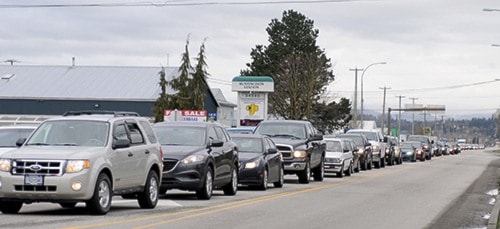by Alina Konevski
Black Press
Abbotsford businesswoman Gerri Charles is thrilled when prom season rolls around, because she gets to host hopeful girls at her dress boutique, Champagne & Lace. But for the last few years, many of these girls take what they learn in Charles’ showroom, and head down to the United States to make a purchase. Charles has had to let some staff go, and finds it difficult to continue saying “yes” to community requests for event sponsorships and raffle ticket purchases.
As the Canadian dollar has grown to parity with the U.S. in the past three years, Canadians living close to the border have been enjoying lower prices in American towns often less than 30 minutes away. They also get generous duty exemptions at the border.
It’s costing Canadian businesses, and their employees, dearly.
In 2010, the City of Bellingham’s finance director, John Carter, conducted a survey. He estimated that Canadian shoppers account for 10 to 20 per cent of all retail sales in Bellingham. That’s at least $140 million to $235 million Canadian dollars flowing to Bellingham every year for general merchandise, restaurant food and drinks, says Carter. And this figure excludes groceries, a major purchase for people regularly shopping down south.
When U.S. retail sales dropped by as much as 30 per cent in 2009, Bellingham saw only a small decrease, and it has already rebounded, says Ken Oplinger, president and CEO of the Bellingham/Whatcom Chamber of Commerce & Industry.
“It was almost entirely because of Canadians coming across.”
On busy summer shopping weekends, the chamber estimates that over half of the cars in big box store parking lots have Canadian plates, mostly from B.C. The estimate for the Costco lot is 70 per cent.
Nationwide, through their 50 million trips across the border, Canadians could be spending as much as 10 per cent of their retail dollars in the United States, according to Bank of Montreal chief economist Doug Porter. That’s more than $20 billion a year.
This means that, while the Bellingham Costco is planning an expansion, and hiring more staff, malls close to the border like Abbotsford’s Sevenoaks Shopping Centre, have seen retail sales impacted, and growth slower than expected.
Trisha Dumouchel, marketing director of Sevenoaks, said as one of the closest malls to the U.S. border in Canada, they’ve noticed a drop in sales because of cross-border shopping.
She said after years of the high Canadian dollar, cross-border shopping has become a habit, and it has only gotten easier with increases in duty-free limits. “It has been a struggle for us… and the government is allowing easier access.”
Dumouchel said that when most people think of “buying local” they think of locally-grown produce, but when purchasing any goods, people need to think about “staying in Canada, supporting our economy and our jobs and community.”
For specialty retailers, employee wages are about 18 per cent of retail sales, says retail consultant John Williams, head of J.C. Williams Group in Toronto. Sales of $140 million – the minimum amount that Canadians are sending to Bellingham annually – correspond with 800 potential retail jobs in Canada.
Charles’ boutique has cut back to 15 employees from 24 in the past four years. The $100 that Abbotsford shoppers might save by buying their prom dress over the line is linked to real jobs lost, she says, and that equates to fewer car and mortgage payments, and less tax income for public services.
“The Canadian consumer misunderstands the dynamics of the tariffs and duties, and thinks that somehow the Canadian retailers are just gouging them, and that there are some inequities we have control over. And we don’t,” says Charles.
When Brent Murdoch’s customers come to his outdoor gear store, Valhalla Pure Outfitters in Abbotsford, they frequently compare his prices to those of stores to the south. Murdoch is forever justifying the 18 per cent duty he has to pay on U.S. items such as tents and footwear, from which American businesses are exempt.
“It really impacts our opportunity to grow. We’re constantly up against that,” he says. “We work very, very hard on the pricing issue. It takes up a lot of my time, just trying to be competitive. But it is difficult.”
There are tariffs on finished goods heading into Canada that don’t exist in the U.S., explains Allan Asaph, executive director of the Abbotsford Chamber of Commerce.

“No amount of shop local promotion is going to compete with people’s price sensitivity. What we need to address is the landed cost to Canadian retailers, so they can be more competitive.”
These price differences were 13 per cent on average last year, according to BMO.
